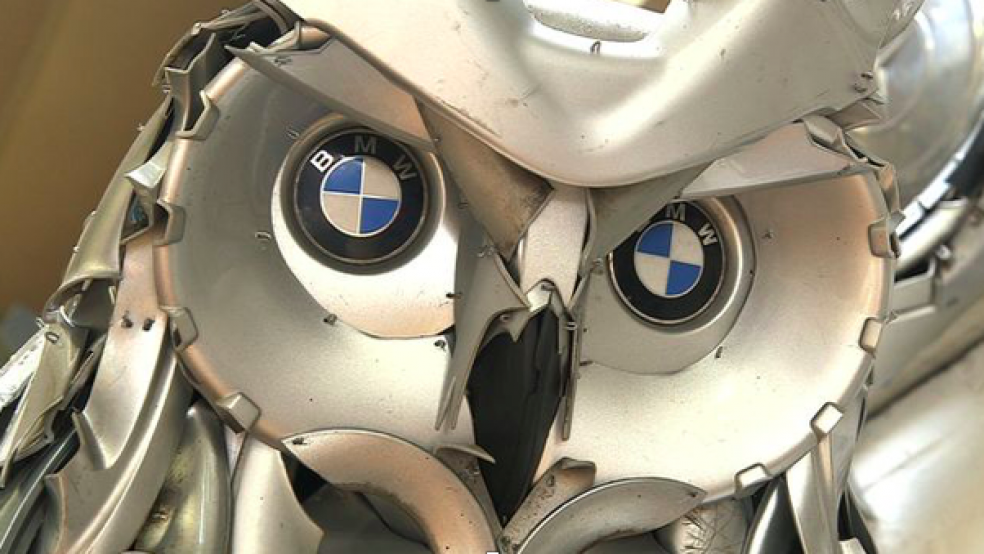
Giving Rubbish Removal an Artful Higher Purpose in Brighton
Ptolemy Elrington is no ordinary man. He is an exceptionally talented UK artist with the extraordinary vision of using reclaimed materials in his work. He aims to divert rubbish removal from the landfills and to broadcast a social message about the importance of recycling and reusing materials by creating beauty from what was once considered rubbish.
Ptolemy Elrington's Primary Medium Is Rubbish
Ptolemy works out of a studio in the seaside resort town of Brighton. He also runs a website dubbed, "Hubcap Creatures," where he shows off some of his latest work. He is most famous for his mesmerizing animal sculptures created from recovered hubcaps and galvanized wire he gets from demolition sites and skips. However, he also uses other reclaimed materials in his artwork, including old shopping trollies, old bicycles, scraped car parts, and anything else that strikes his fancy in rubbish removal piles on his way to his studio in the morning or while scouring the streets for abandoned hubcaps. He likes to brag that his kids are his biggest cheerleaders in these recovery efforts and won't let him pass a hubcab on the street or in a skip without stopping!
Ptolemy Elrington's Source of Inspiration
There seem to be two pivotal experiences in Ptolemy Elrington's life that inspired him to start creating his hubcab creatures and become a messenger for the importance of repurposing rubbish removal. First, when he was young, he lived near a bend in the road where cars tended to lose their hubcabs and they accumulated in that spot. As he passed by these objects, he began to notice the beauty in their form and pattern. Because of this, he began to feel it was a waste to see bin men loading these hubcabs into bin trucks destined for the landfill. Second, Ptolemy Elrington took a year long trip to India in the late 1980s which gave him an in depth look into a culture in stark contrast to the UK. There in India, he saw the resourcefulness that abject poverty brings about. No one threw out a broken item. They always found a way to repair it in some ingenious way or repurpose it into another useful item. This profoundly impacted Ptolemy Elrington's attitude about rubbish and what westerners do with it. When he returned to the UK, his artwork began to draw attention to the importance of repurposing what westerners tend to think of as worthless junk into something of perceived high value.
Rekindling Your Childlike Imagination
When asked what it means to be human, most of us struggle to provide an answer. It's certainly a complicated issue that requires thought from multiple perspectives, some of which we may not always be in touch with until inspired by another human being. If you view Ptolemy Elrington's artwork, hanging from the ceiling of his studio, or exhibited in a public arena, it conjures the imagination of your inner child. It gives you new perspective on what it means to be human and what we do with our waste. You see rubbish turned into fiery dragons, fanciful fish, and the beautiful curvature and pattern of a great blue heron's head and its delicate showy feathers. You see creatures large and small, from whales to frogs. You see the bony plates of an armadillo, the piercing glance of an eagle, and the majestic nature of a great horned owl. It's an Alice In Wonderland moment that can open up your imagination to a new way of thinking about the world and what we do with our rubbish!
Changing the Value of Rubbish
One may argue that the value of rubbish removal that ends up in a landfill is zero or worthless. It consists of discarded stuff that no wants or sees any value in saving, reusing, or recycling. It may be a plastic hubcab on the side of a road that your council paid bin men to collect and transport to the landfill. It is utterly amazing to see how Ptolemy Elrington is able to transform this piece of "worthless" junk into a beautiful work of art that fetches up to forty thousand Euros and one thousand Euros on average. In his genius hands, worthless junk goes from stuff you can't even give away to works of art that people are willing to pay dearly for! He's not only transforming rubbish, he's transforming our mindset in the process!
Sometimes Eccentric People Are the Best At Inspiring Us
Ptolemy Elrington's eccentricities shine through in a delightful way and bring out the best in humanity. In an interview with Empty Kingdom, he described a flea, a creature that most humans view as objectionable, as "utterly fascinating" when viewed through the electron microscope. Since this interview, his artwork has included more insects. So, not only does Ptolemy Elrington see beauty in rubbish, and find a way to make others see it too, he finds beauty in creatures we tend to devalue as well.
What Do Ptolemy Elrington and Daniel Long At Clearabee Have In Common?
Both born in the UK, these two visionaries have a similar higher purpose in mind: to keep rubbish removal from ending up in landfills whenever possible. Both look at rubbish a different way than most people. When Ptolemy Elrington sees an abandoned hubcab glistening in the sun, he sees the artful curves of a sunfish or the grace of beautiful raptor about to take flight. Daniel Long doesn't see "rubbish." He sees an item that still has useful value and purpose if he can get it into the right hands. Both of these visionaries, in very different ways, have been able to elevate the intrinsic value of rubbish in other people's minds. They are both helping to create a different mindset than the throwaway mentality that has been so prevalent in western cultures in recent decades.











